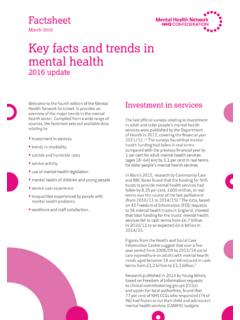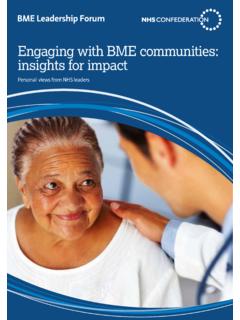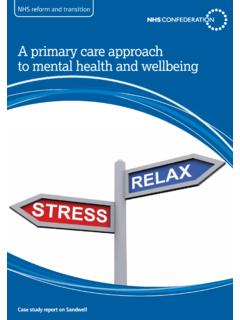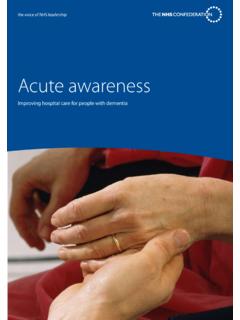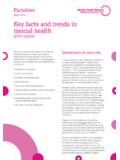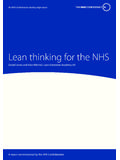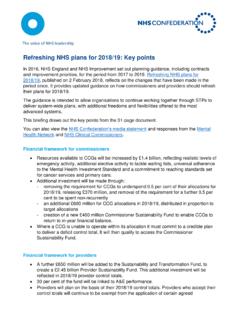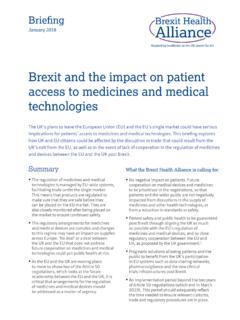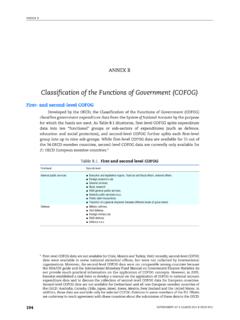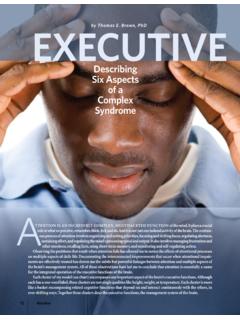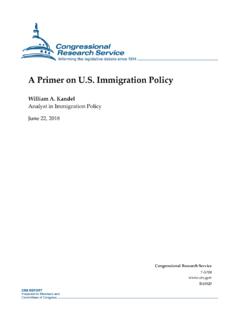Transcription of The CQC has the right to require the provision of ...
1 Fit and proper person test Introduction This briefing provides an update on the requirements placed on NHS provider organisations as of 27 November 2014 to ensure director level appointments meet the fit and proper persons test which has been recently integrated into CQC s registration requirements, and falls within the purview of their regulatory and inspection approach. This document provides a summary of the regulations themselves, as well as a practical toolkit to support provider boards in assuring themselves that they have followed a robust and due process with regards to the fit and proper persons test.
2 NHS Providers has been pleased to work closely with colleagues in the NHS Confederation and NHS Employers in compiling this briefing and we welcome your feedback on its application. Despite our collective concerns at the implications of the new regulations, we have welcomed an open and constructive dialogue with CQC about the practical application of the fit and proper persons test, and we hope to reach agreement that NHS providers can demonstrate use of the toolkit as part of their evidence of compliance with the regulations. For further information, or to discuss, please contact: The regulations The Health and Social Care Act 2008 (Regulated Activities) Regulations 2014 (the 2014 Regulations) places a duty on NHS providers not to appoint a person or allow a person to continue to be an executive director or equivalent or a non-executive director (NED) under given circumstances.
3 The purpose of this briefing for members is: To set out the new requirements of the fit and proper persons test; To set out the role of the CQC; To set out the role of Monitor; To set out NHS foundation trusts and NHS trusts need to do to comply with the regulations; To set out the role of councils of governors; To highlight significant issues for consideration and invite feedback on areas of concern for NHS Providers to address as part of its influencing work. The requirement for fit and proper persons Providers must not appoint a person to an executive director level post (including associate directors) or to a non-executive director post unless they are: Of good character; Have the necessary qualifications, skills and experience; Are able to perform the work that they are employed for after reasonable adjustments are made; Can supply information as set out in Schedule 3 of the Regulations (see the Role of the CQC below).
4 Paragraph 5 (4) of regulations states that in assessing whether a person is of good character,, the matters considered must include those listed in Part 2 of Schedule 4. Part 2 of Schedule 4 refers to: Whether the person has been convicted in the United Kingdom of any offence or been convicted elsewhere of any offence which, if committed in any part of the United Kingdom, would constitute an offence, and Whether the person has been erased, removed or struck off a register of professionals maintained by a regulator of health care or social work professionals. The CQC s definition of good character is not the objective test of having no criminal convictions but instead resets upon a judgement as to whether the person s character is such that they can be relied upon to do the right thing under all circumstances.
5 This implies discretion for boards and councils in reaching a decision and allows for the fact that people can and do change over time. The regulations list categories of persons who are prevented from holding the office and for whom there is no discretion: The person is an undischarged bankrupt or a person whose estate has had a sequestration awarded in respect of it and who has not been discharged; The person is the subject of a bankruptcy restrictions order or an interim bankruptcy restrictions order or an order to like effect made in Scotland or Northern Ireland.
6 The person is a person to whom a moratorium period under a debt relief order applies under Part VIIA (debt relief orders) of the Insolvency Act 1986(40); The person has made a composition or arrangement with, or granted a trust deed for, creditors and not been discharged in respect of it; The person is included in the children s barred list or the adults barred list maintained under section 2 of the Safeguarding Vulnerable Groups Act 2006, or in any corresponding list maintained under an equivalent enactment in force in Scotland or Northern Ireland; The person is prohibited from holding the relevant office or position, or in the case of an individual from carrying on the regulated activity, by or under any enactment; The person has been responsible for, been privy to, contributed to or facilitated any serious misconduct or mismanagement (whether unlawful or not) in the course of carrying on a regulated activity, or discharging any functions relating to any office or employment with a service provider.
7 It will be the responsibility of the chair of the provider to discharge the requirement placed on the provider, to ensure that all directors meet the fitness test and do not meet any of the unfit criteria. The CQC expects senior leaders to set a tone and culture of the organisation that leads to staff adopting a caring and compassionate attitude. It is important therefore that in making appointments boards and councils take account of the values of the organisation and the extent to which candidates provide a good fit with those values. The role of the CQC The regulations give the CQC powers to assess whether both executive and non-executive directors (but not foundation trust governors) are fit to carry out their role and whether providers have put in place adequate and appropriate to ensure that directors are fit and proper persons.
8 The CQC has the right to require the provision of information set out in Schedule 3 of the Regulations and such other information as is kept by the organisation that is relevant to the individual as follows: 1. Proof of identity including a recent photograph. 2. Where required for the purposes of an exempted question in accordance with section 113A(2)(b) of the Police Act 1997(38), a copy of a criminal record certificate issued under section 113A of that Act together with, after the appointed day and where applicable, the information mentioned in section 30A(3) of the Safeguarding Vulnerable Groups Act 2006 ( provision of barring information on request)(39) 3.
9 Where required for the purposes of an exempted question asked for a prescribed purpose under section 113B(2)(b) of the Police Act 1997, a copy of an enhanced criminal record certificate issued under section 113B of that Act together with, where applicable, suitability information relating to children or vulnerable adults. 4. Satisfactory evidence of conduct in previous employment concerned with the provision of services relating to: (a) health or social care, or, (b) children or vulnerable adults. 5. Where a person (P) has been previously employed in a position whose duties involved work with children or vulnerable adults, satisfactory verification, so far as reasonably practicable, of the reason why P s employment in that position ended.
10 6. In so far as it is reasonably practicable to obtain, satisfactory documentary evidence of any qualification relevant to the duties for which the person is employed or appointed to perform. 7. A full employment history, together with a satisfactory written explanation of any gaps in employment. 8. Satisfactory information about any physical or mental health conditions which are relevant to the person s capability, after reasonable adjustments are made, to properly perform tasks which are intrinsic to their employment or appointment for the purposes of the regulated activity.
